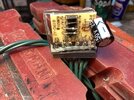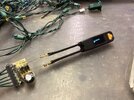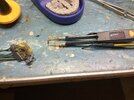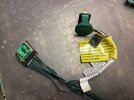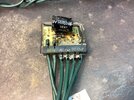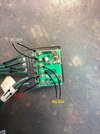Hafcanadian
New Member
I have one of the neighborhood’s more extensive Xmas light displays. Every year one or more sets or strings go haywire, and I try to find the issue. I have minimal electronics acumen, but have ferreted out and repaired a few issues in my day. My soldering skills have improved, and although an essential tremor too often confounds my efforts thereto, I by hook or by crook sometimes manage to get failed appliances, flashlights, automotive and RV devices, and even Xmas strings up and running.
Over the years I’ve accumulated Xmas lights of different sorts, LED and incandescent, plain straight and net style, simple and “in motion” controlled. I have both a Light Keeper Pro and an LED Keeper light repair “guns”. They are relatively useless for module controlled sets, but do help detect failed lamps. It’s the module controlled sets that confound me.
This year some rain water got into one LED net set and it blew both 3A fuses. I took the module apart and dried it, then cleaned up the detritus on the circuit board. One rusted tail of a capacitor broke off, and I resoldered it back in. I think this one runs two 35-lamp sides, 70 lamps total. I took apart the last lamp before the female outlet end plug because it was badly corroded and one LED tail had broken off. I cleaned it, DeoxITed both blades, and put a new lamp in the socket.
It still blows both fuses immediately when plugged in. I’m relatively ignorant on how these things work, so please forgive that. When I put + and - meter probes in the female end plug, I get continuity. Shouldn’t there be no connection between the two, and is this indicative of the short circuit? I can’t see evidence of a short in the board’s connections, but there has to be one somewhere. Is it possibly in a board component - there’s only 4 resistors and a capacitor. There’s no obvious wire damage within the net that would cross short, and there are two sides each of 35 lamps, so I’d expect an in-side short to blow only one fuse, not both.
Any offered clarity to my understanding of how these work would be appreciated.
Joel





Over the years I’ve accumulated Xmas lights of different sorts, LED and incandescent, plain straight and net style, simple and “in motion” controlled. I have both a Light Keeper Pro and an LED Keeper light repair “guns”. They are relatively useless for module controlled sets, but do help detect failed lamps. It’s the module controlled sets that confound me.
This year some rain water got into one LED net set and it blew both 3A fuses. I took the module apart and dried it, then cleaned up the detritus on the circuit board. One rusted tail of a capacitor broke off, and I resoldered it back in. I think this one runs two 35-lamp sides, 70 lamps total. I took apart the last lamp before the female outlet end plug because it was badly corroded and one LED tail had broken off. I cleaned it, DeoxITed both blades, and put a new lamp in the socket.
It still blows both fuses immediately when plugged in. I’m relatively ignorant on how these things work, so please forgive that. When I put + and - meter probes in the female end plug, I get continuity. Shouldn’t there be no connection between the two, and is this indicative of the short circuit? I can’t see evidence of a short in the board’s connections, but there has to be one somewhere. Is it possibly in a board component - there’s only 4 resistors and a capacitor. There’s no obvious wire damage within the net that would cross short, and there are two sides each of 35 lamps, so I’d expect an in-side short to blow only one fuse, not both.
Any offered clarity to my understanding of how these work would be appreciated.
Joel

